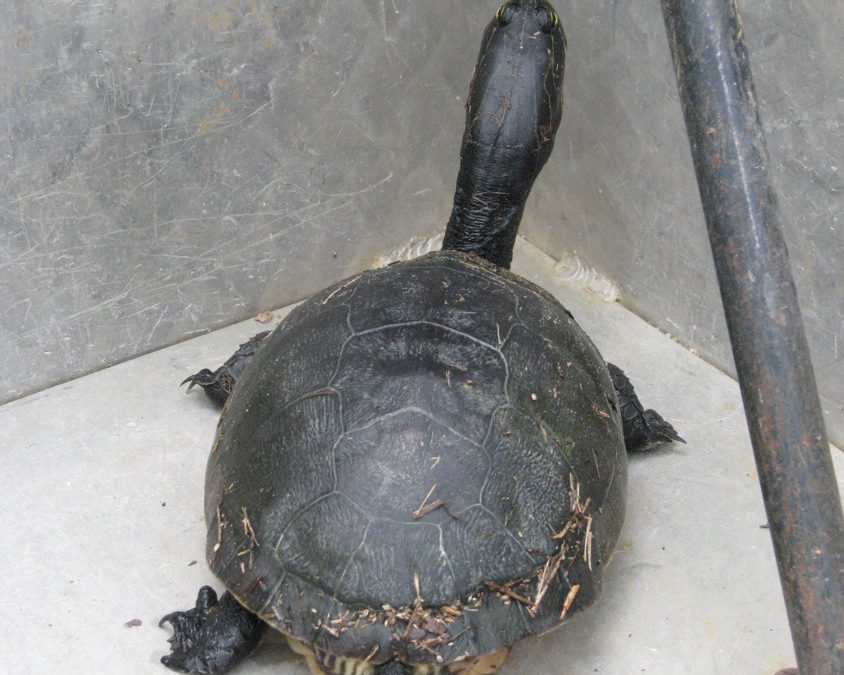
by Rick O'Connor | Apr 19, 2020
Bet you have never heard of these?
Chicken Turtles?
But they exist!
And the reason you probably have not heard of them is because, unlike so many other turtles, they do not spend a lot of time in the water.
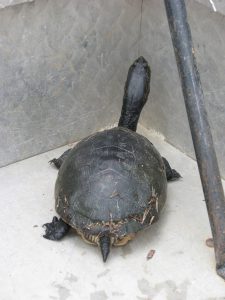
The long neck and oval shell of the Florida Chicken Turtle.
This one is missing a rear leg, probably attacked by a raccoon.
Photo: Molly O’Connor
Chicken turtles are fans of the ephemeral ponds, these are ponds that have water in them after heavy rain but are dry otherwise. These turtles inhabit such locations and hide in the brush and leaf litter during the dry periods. They are predators within this system, feeding on insects and crayfish mostly.
It is one of the many emydid turtles and their shells are more oval in shape than round. It is a dark black to olive color and has a distinct pattern of yellow stripes looking like a fish net on the shell. Most shells are in the 10-inch range in length and, like many species of turtles, the males are smaller. The plastron (belly shell) is a beautiful solid creamy yellow color with no dark marking at all.
This turtle is found in the Atlantic coastal plains and there are two subspecies found in Florida: Deirochelys reticularia reticularia and D. r. chrysea. The primary difference is that D. r. reticularia has a single dark spot on the underside of the marginal scutes of the bridge connecting the carapace to the plastron; D. r. chrysea does not have these spots. D. r. reticularia are found north and west of the Suwannee River and D. r. chrysea are found in the peninsula south of the Suwannee.
Most of the ponds where these turtles have been found are less than 20 inches deep. It seems to avoid river flood plains, preferring small ponds in savannas, sandhill depressions, and wetlands. They seem to be out more in the early mornings and shortly after sunset.
Unlike most emydid turtles, chicken turtles BEGIN their nesting season in August and continue into the winter. The females wander over open ground seeking good nesting sites. They prefer open grassy areas and dig the nest during daylight hours. The average number of eggs deposited is around 10 and, like other turtles, more than one clutch will be laid each season.
They do not seem to be very abundant in the ponds they inhabit; 3-5 turtles/hectare seems to about the norm. When encountered in the water, they seem to be solitary. As mentioned, their favorite foods are arthropods – primarily insects and crayfish.
It appears one of the largest threats in our state is roadkill. Seasonal changes in rainfall force the turtles to move and, being more active in winter when we have more visitors, road kills are common. Raccoons also take quite of few from their habitat of not living in deep water. And there is ALWAYS the issue of habitat loss – the number one cause of biodiversity declines everywhere. Florida continues to grow, and these turtles will continue to be threatened.
I have only found one of these in the years I have been “turtling”. It was pretty exciting, and it was a day or so before we figured out what kind it was – you don’t see chicken turtles very often, so it was a surprise. It was missing one leg, we are guessing raccoon attack, and we kept it for the afternoon before letting it go. I have not seen one since.
That said, they are around – and I hope you find one someday. It is one of those rare finds.
Hopefully, you will be able to get out and discover many of Florida’s turtles during this YEAR OF THE TURTLE.
References
Meylan P.A. (Ed). 2006. Biology and Conservation of Florida Turtles. Chelonian Research Monographs No.3, 376 pp.
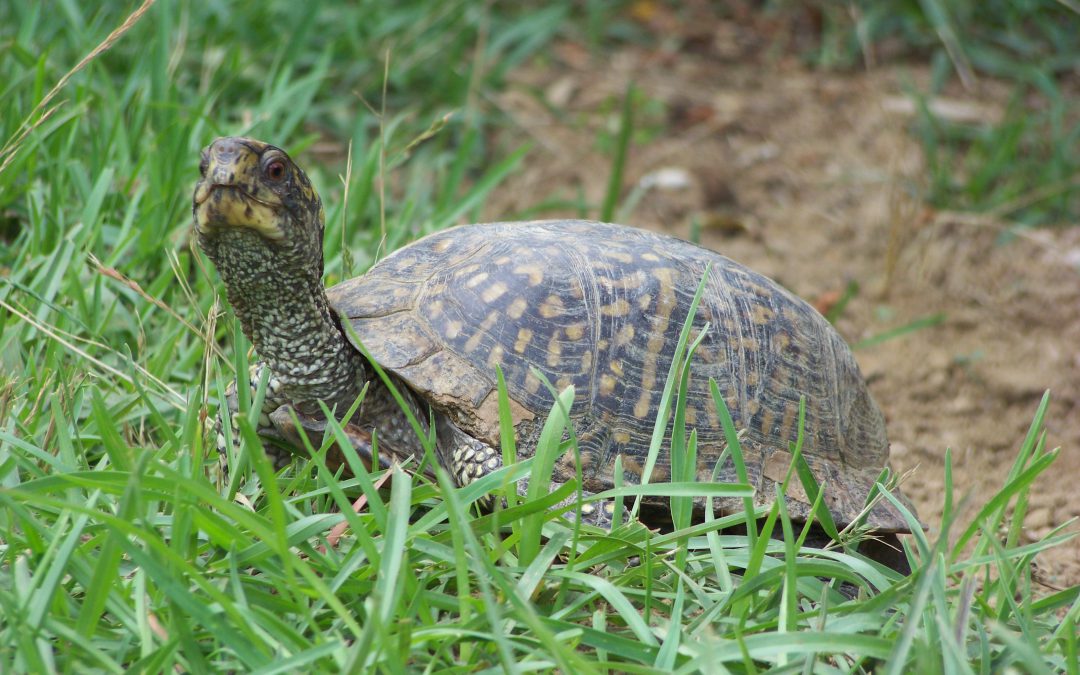
by Rick O'Connor | Apr 7, 2020
These are some of the more familiar Florida turtles we have. Working with youth, I often hear them called “snapping turtles” because (a) these are the most common turtles they encounter, and (b) snapping turtles are the only name they know 😊
I myself had a “pet” box turtle when I was young named… “snappy”. Yep…
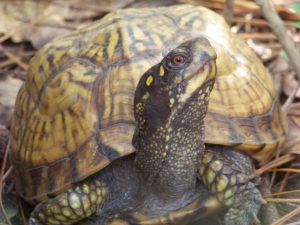
This Gulf Coast box turtle has a lot of yellow on the shell. Their shell coloration varies.
Photo: Molly O’Connor
That said, they do seem to be very common everywhere. Neighborhoods, parks, gardens, farms, you name it, people find these things. However, research suggests that the “commonness” of these guys maybe just in encounters with the same individuals, we really do not know how common they are.
They are a great way to introduce youth to the world of turtles. When picked up they quickly withdraw and close their shells – the only turtles we have that can completely do this (watch out though, they do have a habit of urinating when held).
There is debate as to how many kinds of box turtles we have. Most agree that the four that have been listed are all subspecies of Terrapene carolina. This turtle is typically called the “Eastern” box turtle. This species does exist and is quite common along the Atlantic seaboard. If differs from other subspecies in that the back end of the carapace ends abruptly – there is no “flare” to the margins of the carapace.
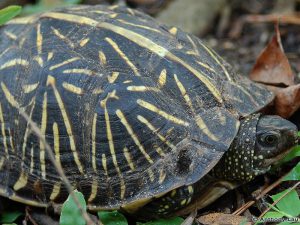
The lined pattern of this carapace identifies it as the Florida box turtle.
Photo: Florida Museum of Natural History
What they do agree on is that two subspecies – the Florida box turtle (T. carolina bauri) does live in Florida – in the peninsular part of the state; and the Gulf Coast box turtle (T. c. major) does as well – in the panhandle. The two that are questionable are the Eastern box turtle (T. c. carolina) and the Three-toed box turtle (T. c. triunguis). As said before the Eastern definitely exists north of us but not sure whether it is in Florida. The Three-toed lives west of us but, again, not sure in Florida.
The Florida box turtle has a dark carapace with straight lined yellow streaks (like a sunbeam burst) pattern across its shell. The back end of the shell ends abruptly as it does in the Eastern. The Gulf Coast box turtle is the big boy of the group. Most of these box turtles have carapace lengths no more than 7 inches long. The Gulf Coast can be as long as 8 inches and the back-end margin of the carapace is flared. The pattern of color on the Gulf Coast varies. It can be red, yellow, brown and the lighter colored markings can be varied as well.
Box turtles are emydid turtles – which are usually associated with freshwater – but box turtles are much more terrestrial than their cousins. Some even referred to them as tortoises, but they are not. They like a variety of habitats being found in dry scrub pine forests, damp wet palm hammocks, and occasionally in marshes. Their hind feet are slightly webbed, but they are not great swimmers and are rarely found in deep water. That said, they do love rain. When it rains, they are on the move looking for food and places to lay eggs.
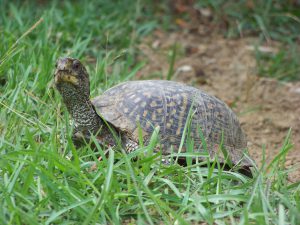
The abrupt downward end of the carapace and blotched pattern of the shell identifies this as an Eastern box turtle.
Photo: Molly O’Connor
Research suggests that each turtle will inhabit about 5 acres and that a single acre can support up to 16 animals. They are omnivorous and eat a variety of invertebrates and plants – they particular like worms and snails. They have also been known to feed on dead animals lying about, – and this should make some folks happy… they like to eat cockroaches!
Males look different than females in that their plastron has a concaved depression in it and their tails are much longer. Females will usually lay about 2 eggs in a nest she digs during rainy afternoons. She will lay more than one nest each season usually producing about 9 eggs each year. Baby box turtles are usually dark brown with a yellow stripe running down the middle of their carapace.
Many turtles, eggs, and hatchlings are lost to predators. Fire ants are a big problem as are birds, mammals and reptiles. Scarlet snakes are particularly good at finding nests. Most adults’ bare scars from attacks but usually survive by withdrawing into their shells. One animal, the wild pig, is believed to be strong enough to crush the entire shell consuming the turtle. Raccoons are also good at grabbing a limb before they can withdraw – there are many 3-legged box turtles running around, but they seem fine and still hunt well.
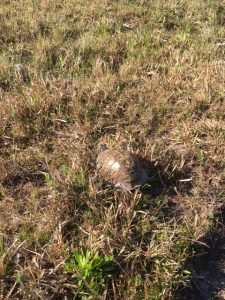
Gulf Coast box turtle heading across an open field.
Photo: Molly O’Connor
One problem they do have is fire. They prefer wooded areas, even the flowerbeds around your house. They do not dig burrows like the gopher tortoise but rather make “forms” in the pine straw or leaves – where they spend the cold and hot days of the year – they also do not like low humidity days and will build forms during these times as well – but these do not protect them from fires, whether wildfires or prescribed ones.
Despite all of this – they are one of the longer-lived turtles in our state. Though most do not reach the age of 40 years these days, they have the ability to reach 100!
No doubt this is one of the coolest turtles we have – and we really enjoy encountering them. Take a walk around after a rainy day and see if you can find one in your yard!
References
Meylan P.A. (Ed). 2006. Biology and Conservation of Florida Turtles. Chelonian Research Monographs No.3, 376 pp.
by Rick O'Connor | Mar 20, 2020
As with mud turtles, full grown musk turtles are no bigger than your hand. They differ from mud turtles in that they have a single hinge on their plastron and the scutes just above that hinge are rectangular instead of triangular. Like mud turtles, they are very aquatic and not seen basking or out of water at anytime other than to lay eggs. Also like mud turtles, few people know they exist.
There are only two species in Florida, the Loggerhead Musk (Sternotherus minor) and the Common Musk (Sternotherus odoratus). There is a subspecies of the Loggerhead Musk in the far western panhandle, the striped-necked (Sternotherus minor peltifer).
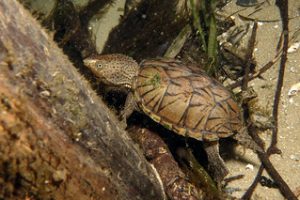
Loggerhead Musk Turtle.
Photo: Flickr
The Loggerhead Musk is found through much of the southeastern United States and much of Florida. Like all musk and mud turtles it is small, with an average carapace length of 6 inches. The carapace will have 3 keels and small black flecks scattered across the light brown/olive colored shell. The head is large and wide with large jaws for crushing mollusk shells, a favorte food. The head is light colored with dark markings and 2 barbels (fleshy whiskers) under the chin. These barbels are chemosynthetic and help locate food. There are no striped on the head.
They prefer to walk across the bottom of either calm or flowing waterways, rarely leaving the water and have been found as deep as 44 feet into springs. In the waterways where they are found they have some of the highest densities of any turtle in the area – as much as 3000 individuals in a hectare. They breed in both fall and spring and the female usually does not travel far from the water to lay her eggs. Eggs have been found near logs and stumps. She will usually lay about 1-5 and they may take 100 days to incubate. Loggerheads feed on insects when young and switch to mollusk as adults. They have been known to eat other small turtles in captivity. They are preyed upon by alligator snapping turtles and maybe the alligator itself. They have been popular in the pet trade.
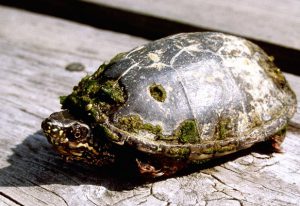
This common musk turtle (stinkpot) shows the dark head with stripes but also shows at bullet hole from a practice by some people called “plinking”. Where they practice shooting at turtles.
The Common Musk turtle is just that… common. It is found across the entire eastern portion of the United States and all of Florida. As its scientific name suggests (S. odoratus) it releases a pungent musk from glands near the bridge between the carapace and the plastron. This strong musk gives the turtle is other common name “Stinkpot”.
It too has a carapace about 6 inches long but differs from the Loggerhead in that its head is dark with 2 Yellow-White stripes running laterally. There is also a notch in the plastron near the tail. It is very aquatic, and can be found in high densities, but prefers still quite waters. They are known to be deep divers as well, diving to depths of 30 feet.
They will nest more inland than Loggerheads and usually lay multiple clutches of 1-9 eggs sometimes not burying them. Stinkpots are omnivorous, preferring mollusk but will also consume other invertebrates and seeds. Being small, they are preyed upon by raccoons, wading birds, fox, skunks, water snakes, hawks, eagles, alligators, snapping turtles, bull frogs, and even large mouth bass.
The handling of small turtles must be done with care. They have a long reach and nasty bite. But they are very cool turtles and very common. It is very cool to see them while snorkeling or paddling our rivers and springs.
Resource:
Meylan, P.A. (Ed.). 2005. Biology and Conservation of Florida Turtles. Chelonian Research Monographs No. 3, 376 pp.
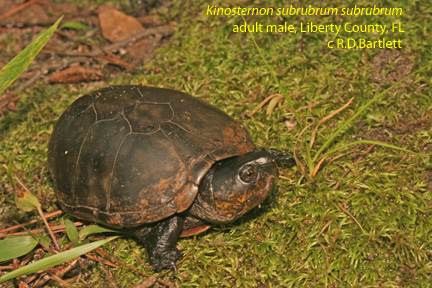
by Rick O'Connor | Mar 3, 2020
This is a new one for many of you… mud turtles. Most have never heard of them. They are very small turtles with oval shaped, domed shells that have hinges similar to box turtles. There are actually two genera within this family of small turtles, the mud turtles (Kinosternon) and the musk turtles (Sternothurus). There are two species of each found in Florida and they differ in that the mud turtles have two hinges on their plastron (belly shell) and the musk only have one. In this post, we will focus on the mud turtles.
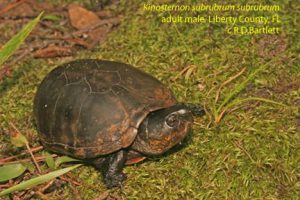
The small, but cool, eastern mud turtle.
Photo: Charles Bartlett
As mentioned above, mud turtles differ in that they have two moveable hinges on their plastron. Also, the scutes (scales) anterior of the anterior most hinge is triangle in shape instead of square. There are two species of mud turtles in Florida. The Striped Mud Turtle (Kinosternon baurii) is a resident of peninsula part of our state. Found from the Apalachicola River to the Florida Keys, this turtle differs from the Eastern Mud Turtle in having three yellow longitudinal stripes on the carapace (though these stripes be faint or missing in the northern part of the state). The carapace has a concave depression on each side of the backbone and the head is usually striped. The length of the carapace is usually not more than 4”.
The Eastern Mud Turtle (Kinosternon subrubrum) has three subspecies. The Eastern Mud Turtle (Kinosternon subrubrum subrubrum) is found in northern Florida and differs from the Striped Mud in having a mottled head in lieu of a striped one. The Florida Mud Turtle (Kinosternon subrubrum steindachneri) also has a mottled head but is found in the peninsula part of the state (but not the Keys). The Mississippi Mud Turtle (Kinosternon subrubrum hippocrepis) has two stripes on the head and is only found in the far western panhandle. This species lacks the stripes and concaved carapace. They too are small, with carapace lengths from 3 – 5 inches. This species has a much-reduced plastron, similar to snapping turtles.
The striped mud can be found in either quiet or flowing waters, where the eastern mud(s) prefer quiet waters with lots of vegetation. In the Florida Keys numerous striped muds have been found in ditches and roadside ponds. They have been in brackish water up to 15 ppt. Stripes are known to make long overland movements during rain and can remain there for several weeks. It is believed they are seeking nesting areas. Eastern muds have been known to make overland movements but not to the extent of the striped muds, and many eastern muds are known to not make these trips at all.
Both species are known to nest in the spring, but the striped muds have a fall nesting season as well. Unusual for turtles, male eastern muds are larger than the females. Male striped muds will have a concave plastron, similar to what the terrestrial turtles (gopher tortoise and box turtles) have. Both will find sandy spots and lay between one and eight small eggs.
Both species are omnivorous. Striped muds like seeds, leaves, and insects. Eastern muds consume primarily insects, crustaceans, and mollusks. Predators are numerous. As with all turtles, just about everyone consumes eggs and hatchlings. Being small, adults have their predators as well. Alligators, snakes, opossums, raccoons, crows, gars, and even blue crabs have been known to take them. The long wanderings of the striped mud have brought many of them into contacts with cars on highways.
The population status is not well known for this group. There are many research gaps that need to be filled. They are not currently listed in Florida, though the striped mud is listed as endangered in the Florida Keys. It appears the primary cause of their decline has been development.
Resource:
Meylan, P.A. (Ed.). 2006. Biology and Conservation of Florida Turtles. Chelonian Research Monographs No. 3, 376 pp.
These are small turtles but have a big heart! They can retract into their shells but will take a snip at one’s hand if not careful. They are pretty cool really and one of the special turtles in our state.
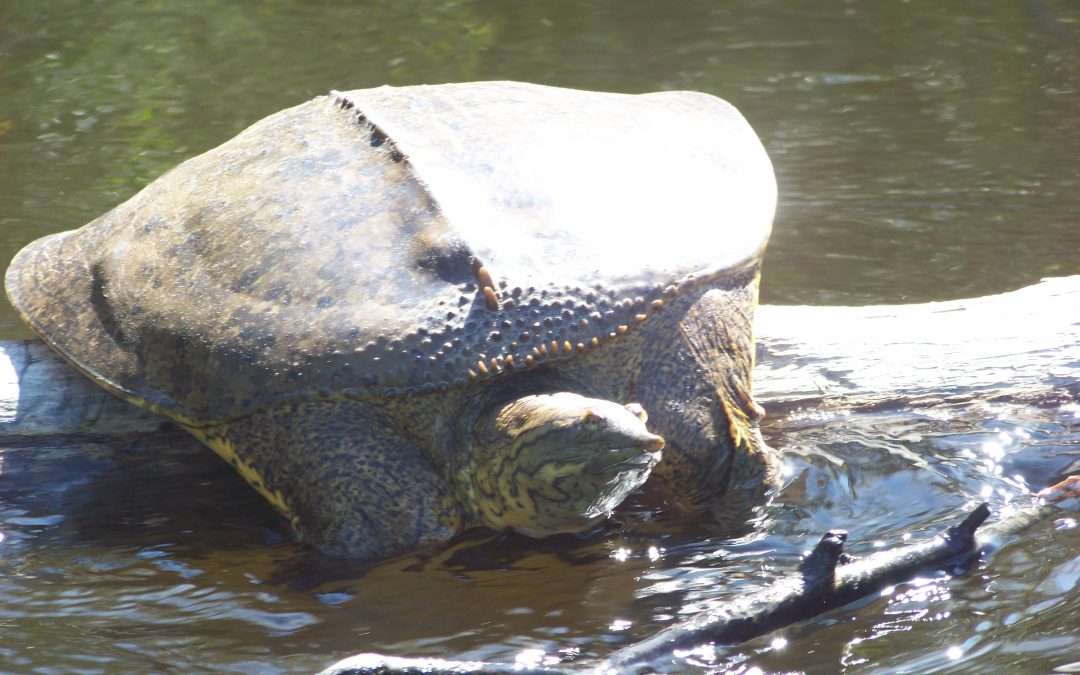
by Rick O'Connor | Feb 20, 2020
These are some of the most unique turtles in the Order Chelonia. Softshells are very distinct with their flat, leathery shells and long tubular snouts. These guys like to lie beneath the sand of Florida’s rivers, buried except their eyes and snout, awaiting passing fish to ambush. They have very long necks to extend their reach during a strike and three sharp bony plates in the roof of their mouths to rip fish flesh. Those handling these should be careful. They have a LONG reach and a nasty bite.
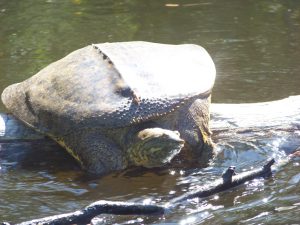
A large Florida softshell turtle basking on a log in Blackwater River.
Photo: Molly O’Connor
There are believed to be 22 species of softshells around the globe but only three live in Florida, and two of those are only found in the western panhandle, one is only found in Escambia County.
The Florida softshell (Apalone ferox) is found throughout the state. Unlike the other Florida species, this one can be found in slow moving streams, ponds, lakes, retention ponds, and even some brackish systems. It prefers to NOT inhabit faster moving rivers. It is the largest of the Florida softshells reaching a carapace length of 30 inches (2.5’) and a mass of 100 pounds! Like many turtles, females are large than males. Besides size, the Florida softshell can be distinguished from the others by the low, round tubercles along the nape of the carapace. This turtle is often seen basking in quiet waterways and will defend itself aggressively. Like many freshwater turtles, Florida softshells nest during daylight hours in sandy soils. They typically lay 15-25 eggs and more than one clutch a year. Unlike other freshwater turtles, sex is not determined by egg temperature but rather by genetics. Though they are fish eaters, much of their diet consist of snails and insects. Crayfish, clams, snakes, turtles, and birds (though rare) have been found in their gut. This species has few predators as adults but are heavily preyed upon by humans for the food markets outside of Florida.
The Gulf Coast Spiny Softshell (Apalone spinifera aspera) is smaller than the Florida softshell, but larger than the Gulf Coast Smooth, with maximum carapace length at 18 inches. They can be distinguished from the other softshells by having spiny, or spike looking tubercles along the nape of the carapace. The hatchlings are tan with numerous small spots and dark thin lines along the margin of the carapace. In Florida, this softshell is only found in the panhandle and in the St. Marys River in Nassau County. It prefers fast moving rivers but will move into quieter waters if the Florida softshell is not present. Like many turtles, they nest during daylight hours in sandy soils during the spring. Clutch size is 20-25 eggs and they lay more than one clutch per year. Incubation is between 60-70 days. They are bottom feeders feeding mostly on crayfish and fish. There are few adult predators and no commercial fishery for this species.
The Gulf Coast Smooth Softshell (Apalone mutica calvata) has only been found in Escambia County within our state. As the name implies, the nape of the carapace does not have the round or spike-like tubercles – rather, it is smooth. It is a smaller softshell, with a carapace length of 12 inches. The young have large circular spots which are harder to see in adults. It has a milder disposition than most softshells, preferring to withdraw into the shell rather than bite. It prefers rivers over other types of water bodies and has only been found in the Escambia River within our state, and only in the upper – faster moving portions of it. They have been found in quiet waters connected to this river. It seems to like sections of the river where sandbars are common, buried in sand near them awaiting fish. They will quickly retreat to the deep part of the river when encountered. The GCSS will use these sandbars for nesting in the spring, laying only about 6-8 eggs, and typically more than one clutch each season. The eggs incubate for 60-70 days and sex is determined by genetics, not temperature. Though fish eaters, insects are much of their diet. There is no commercial fishery for this small turtle.
Like all turtles, nest predation is high for softshells, but river flooding also takes a lot of nests.
All freshwater turtles afford some protection (more some than others). Residents can collect no more than one softshell/day for noncommercial use, no more than two in your possession, and no eggs.
These are really neat looking turtles and it is very exciting to see them while paddling our rivers. We hope you get to see one soon.
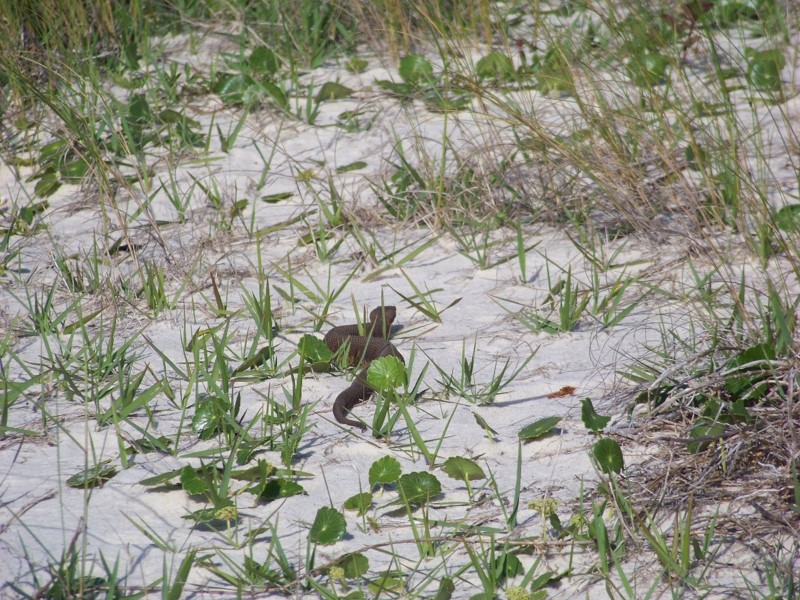
by Rick O'Connor | Feb 13, 2020
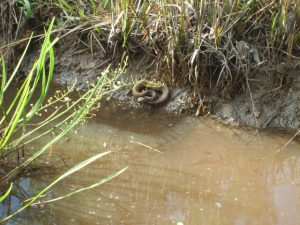
An eastern cottonmouth basking near a creek in a swampy area of Florida.
Photo: Tommy Carter
When you think of reptiles you typically think of tropical rainforest or the desert. However, there is at least one member of the three orders of reptiles that do live in the sea. Saltwater crocodiles are found in the Indo-Pacific region as are about 50 species of sea snakes. There is one marine lizard, the marine iguana of the Galapagos Islands, and then the marine (or sea) turtles. These are found worldwide and are the only true marine reptiles found in the Gulf of Mexico.
Sea turtles are very charismatic animals and beloved by many. Five of the seven species are found in the Gulf. These include the Loggerhead, which is the most common, the Green, the Hawksbill, the Leatherback, and the rarest of all – the Kemp’s Ridley.
Many in our area are very familiar with the nesting behavior of these long-ranged animals. They do have strong site fidelity and navigate across the Gulf, or from more afar, to their nesting beaches – many here in the Pensacola Beach area. The males and females court and mate just offshore in early spring. The females then approach the beach after dark to lay about 100 eggs in a deep hole. She then returns the to the Gulf never to see her offspring. Many females will lay more than one clutch in a season.
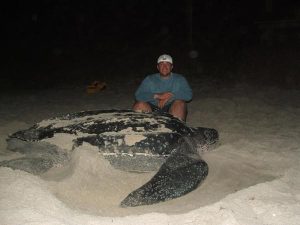
The largest of the sea turtles, the leatherback.
Photo: Dr. Andrew Colman
The eggs incubate for 60-70 days and their temperature determines whether they will be male or female, warmer eggs become females. The hatchlings hatch beneath the sand and begin to dig out. If they detect problems, such as warm sand (we believe meaning daylight hours) or vibrations (we believe meaning predators) they will remain suspended until those potential threats are no more. The “run” (all hatchlings at once) usually occurs under the cover of darkness to avoid predators. The hatchlings scramble towards the Gulf finding their way by light reflecting off the water. Ghost crabs, fox, raccoon, and other predators take almost 90% of them, and the 10% who do reach the Gulf still have predatory birds and fish to deal with. Those who make it past this gauntlet head for the Sargassum weed offshore to begin their lives.
These are large animals, some reaching 1000 pounds, but most are in the 300-400 pound range, and long lived, some reaching 100 years. It takes many years to become sexually mature and typically long-lived / low reproductive animals are targets for population issues when disasters or threats arise. Many creatures eat the small hatchings, but there are few predators on the large reproducing adults. However, in recent years humans have played a role in the decline of the adult population and all five species are now listed as either threatened or endangered and are protected in the U.S. There are a couple of local ordinances developed to adhere to federal law requiring protection. One is the turtle friendly lighting ordinance, which is enforced during nesting season (May 1 – Oct 31), and the Leave No Trace ordinance requiring all chairs, tents, etc. to be removed from the beach during the evening hours. There are other things that locals can do to help protect these animals such as: fill in holes dug on the beach during the day, discard trash and plastic in proper receptacles, avoid snagging with fishing line and (if so) properly remove, and watch when boating offshore to avoid collisions.
If we include the barrier islands there are more coastal reptiles beyond the sea turtles. There are freshwater ponds which can harbor a variety of freshwater turtles. I have personally seen cooters, sliders, and even a snapping turtle on Pensacola Beach. Many coastal islands harbor the terrestrial gopher tortoise and wooded areas could harbor the box turtles. In the salt marsh you may find the only brackish water turtle in the U.S., the diamondback terrapin. These turtles do nest on our beaches and are unique to see. Freshwater turtle reproductive cycles are very similar to sea turtles, albeit most nest during daylight hours.
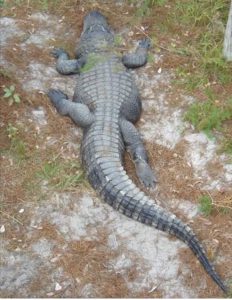
An American Alligator basking on shore.
Photo: Molly O’Connor
The American alligator can also be found in freshwater ponds, and even swimming in saltwater. They can reach lengths of 12 feet, though there are records of 15 footers. These animals actually do not like encounters with humans and will do their best to avoid us. Problems begin when they are fed and loose that fear. I have witnessed locals in Louisiana feeding alligators, but it is a felony in Florida. Males will “bello” in the spring to attract females and ward off competing males. Females will lay eggs in a nest made of vegetation near the shoreline and guard these, and the hatchlings, during and after birth. They can be dangerous at this time and people should avoid getting near.
We have several native species of lizards that call the islands home. The six-lined race runners and the green anole to name two. However, non-native and invasive lizards are on the increase. It is believed there are actually more non-native and invasive lizards in Florida than native ones. The Argentina Tegu and the Cuban Anole are both problems and the Brown Anole is now established in Gulf Breeze, East Hill, and Perdido Key – probably other locations as well. Growing up I routinely find the horned lizard in our area. I was not aware then they were non-native, but by the 1970s you could only find them on our barrier islands, and today sightings are rare.
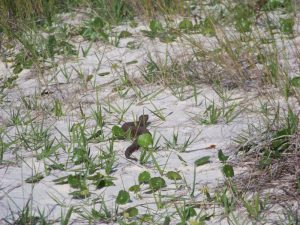
An eastern cottonmouth crossing a beach.
Photo: Molly O’Connor
Then there are the snakes.
Like all reptiles, snakes like dry xeric environments like barrier islands. We have 46 species in the state of Florida, and many can be found near the coast. Though we have no sea snakes in the Gulf, all of our coastal snakes are excellent swimmers and have been seen swimming to the barrier islands. Of most concern to residents are the venomous ones. There are six venomous snakes in our area and four of them can be found on barrier islands. These include the Eastern Diamondback Rattlesnake, the Pygmy Rattlesnake, the Eastern Coral Snake, and the Eastern Cottonmouth. There has been a recent surge in cottonmouth encounters on islands and this could be due to more people with more development causing more encounters, or there may be an increase in their populations. Cottonmouths are more common in wet areas and usually want to be near freshwater. Current surveys are trying to determine how frequently encounters do occur.
Not everyone agrees, but I think reptiles are fascinating animals and a unique part of the Gulf biosphere. We hope others will appreciate them more and learn to live with and enjoy them.


















